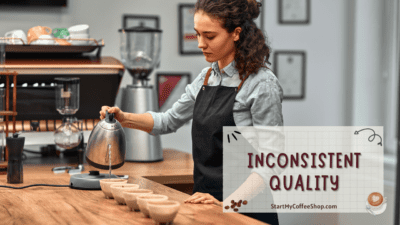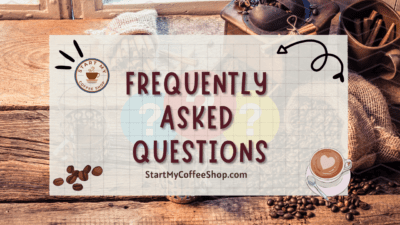In the ever-evolving landscape of the coffee industry, a comprehensive business plan is essential for the effectiveness of any coffee shop venture. One crucial component of this plan is conducting a SWOT analysis. SWOT stands for Strengths, Weaknesses, Opportunities, and Threats, and it provides a framework for assessing the internal and external factors that can impact the business.
A SWOT analysis of a coffee shop business plan reveals its internal strengths, weaknesses, external opportunities, and threats. By understanding these factors, the coffee shop can leverage its strengths, address weaknesses, seize opportunities, and navigate potential threats to achieve growth in a competitive market.
In this article, I will delve into the SWOT analysis of a coffee shop business plan, examining the various aspects that can influence its growth and sustainability.
SWOT Analysis
Strengths
A coffee shop’s strengths lie in the internal attributes that give it a competitive advantage. These factors contribute to its performance and differentiate it from competitors. Here are a few key strengths a coffee shop might possess:

- Location: Firstly, it enhances visibility, ensuring that the coffee shop catches the attention of passersby and potential customers. This increased visibility can lead to higher foot traffic and brand exposure.
Secondly, a bustling area provides greater accessibility, making it easier for customers to reach the coffee shop. Whether it’s a busy downtown district, a commercial hub, or a popular neighborhood, being in the midst of activity ensures that the coffee shop is conveniently located for its target market.
Additionally, the presence of other businesses, offices, or institutions nearby can attract a diverse range of customers, from office workers seeking a caffeine fix to students looking for a study spot.
Read more about: Cost to Open Coffee Shop: Breaking Down the Bucks
Overall, a prime location in a bustling area acts as a launchpad for the coffee shop, fostering a steady flow of customers and contributing to its growth and profitability.
- Unique Value Proposition: Setting a coffee shop apart from the competition requires a unique value proposition. By offering a distinct blend of coffee, signature drinks, or a specialized menu, a coffee shop can create a memorable experience for customers and cultivate a loyal following.
The key to a great unique value proposition lies in the ability to differentiate the coffee shop from others in the market. This could involve creating proprietary blends or sourcing high-quality beans from specific regions, ensuring a unique taste that customers can’t find elsewhere.
Crafting signature drinks that are exclusive to the coffee shop adds an element of novelty and intrigue. These drinks could be innovative concoctions or creative twists on classic recipes, designed to captivate the taste buds of customers.
Moreover, a specialized menu catering to specific dietary preferences, such as vegan, gluten-free, or organic options, can attract a niche customer base and foster loyalty.
- Exceptional Customer Service: Going beyond simply serving coffee, it involves creating a welcoming atmosphere and providing a memorable experience for customers. Friendly and efficient service sets the tone for positive interactions, making customers feel valued and appreciated.
The staff plays a crucial role in delivering exceptional customer service. Knowledgeable baristas who are well-versed in coffee brewing techniques, flavor profiles, and menu offerings can engage customers in meaningful conversations, sharing their expertise and recommendations.
This not only enhances the overall customer experience but also instills a sense of trust and confidence in the coffee shop. A warm and inviting atmosphere further contributes to exceptional customer service. Comfortable seating, cozy decor, and attention to detail in the ambiance create a space where customers feel comfortable lingering, socializing, or simply enjoying their coffee.
Going the extra mile to personalize the experience by remembering customer preferences, offering attentive service, and being responsive to feedback and concerns can leave a lasting impression.
- Branding and Marketing: A well-defined brand identity, encompassing the coffee shop’s values, mission, and unique selling points, forms the foundation.
It should be reflected in the logo, visual elements, and overall aesthetic of the coffee shop. Consistency in messaging and visuals across various platforms helps establish a recognizable and memorable brand.
Engaging social media presence is vital in today’s digital age. Leveraging platforms like Instagram, Facebook, and Twitter allow the coffee shop to showcase its offerings, engage with customers, and build a community.
Providing an exceptional customer experience, going above and beyond expectations, and encouraging customers to share their positive experiences can lead to organic recommendations and increased customer engagement.
Partnering with influencers, collaborating with local businesses, and participating in community events further boosts brand visibility and reinforces the coffee shop’s connection with its target market.
Weaknesses
Weaknesses are internal factors that can hinder the improvement of a coffee shop. Identifying and addressing these areas of improvement is vital for sustainable growth. Here are some common weaknesses in the context of a coffee shop business plan:

- Inconsistent Quality: The pressure to serve customers quickly and efficiently can sometimes compromise the quality of coffee brewing, food preparation, and overall service. Inconsistent quality can lead to dissatisfied customers, negative reviews, and a decline in reputation.
To address this challenge, coffee shop owners must prioritize staff training and development. By ensuring that baristas and kitchen staff are well-trained in brewing techniques, food handling, and customer service, they can consistently deliver a high standard of quality. Implementing standard operating procedures, checklists, and quality control measures can also help maintain consistency.
Read more about: Cost to Open a Small Coffee Shop: The Road to Rich Aroma
Regular monitoring and feedback loops allow the management to identify areas for improvement and take corrective actions promptly. Investing in reliable equipment and using fresh, high-quality ingredients contribute to the consistent output.
Effective communication and teamwork among staff members are crucial for seamless operations and maintaining quality standards. By prioritizing consistent quality, a coffee shop can establish a strong reputation for excellence and attract loyal customers who appreciate the consistently delightful experience they receive, even during peak hours.
- Limited Space: Limited space can pose challenges for a coffee shop, affecting both its growth potential and customer satisfaction. Inadequate seating arrangements, congested floor plans, or a lack of space for expansion can hinder the overall experience.
Insufficient seating can lead to overcrowding, leaving customers frustrated and discouraged from spending time at the coffee shop. It may also result in longer wait times, impacting customer satisfaction and loyalty.
A congested floor plan can move within the coffee shop difficult and uncomfortable, leading to a cramped and uninviting atmosphere. Additionally, limited space for expansion can restrict the coffee shop’s ability to accommodate more customers or offer additional services.
However, there are strategies to mitigate these challenges. Optimizing the existing space through efficient layout design and clever seating arrangements can maximize capacity and improve customer flow. Incorporating flexible seating options, such as communal tables or cozy nooks, allows for versatility and caters to different customer preferences.
Embracing technology, like online ordering or mobile payment systems, can streamline operations and alleviate congestion during peak hours. While expanding physical space may not always be feasible, creative solutions such as outdoor seating or collaborating with nearby businesses for overflow options can help alleviate space constraints.
- High Operating Costs: High operating costs can pose a significant challenge for coffee shops, particularly smaller establishments. Expenses such as quality ingredients, rent, equipment maintenance, and staff salaries can exert considerable pressure on profit margins.
The cost of sourcing high-quality coffee beans, fresh ingredients for food items, and specialty items can be substantial. Renting a prime location in a bustling area often comes with a hefty price tag.
Additionally, ensuring the proper maintenance of equipment, such as coffee machines, grinders, and refrigeration units, requires regular investments. Staff salaries, including baristas, kitchen staff, and managerial roles, further contribute to operating costs.
To address these challenges, coffee shop owners must carefully manage expenses. Negotiating favorable supplier contracts, seeking bulk purchase discounts, and optimizing inventory management can help mitigate ingredient costs.
Exploring alternative locations or considering shared spaces can provide cost-effective options for rent. Implementing preventive maintenance schedules and training staff on equipment upkeep can minimize repair and replacement costs. Labor cost management, including efficient scheduling and cross-training, can help optimize staffing expenses.
- Reliance on Seasonal Demand: Coffee shops often face the challenge of relying on seasonal demand, as coffee consumption trends tend to fluctuate throughout the year. Understanding and adapting to these seasonal variations is crucial for managing sales and revenue effectively.
During colder months, hot beverages like cappuccinos and lattes tend to be more popular, while iced coffees and cold brews become the preferred choice during the warmer months. These shifts in consumer preferences can result in noticeable fluctuations in sales volume and revenue.
To mitigate the impact of seasonal demand, coffee shop owners can employ various strategies. Offering a diverse menu that caters to both hot and cold beverages allows customers to find their preferred choice regardless of the season.
Furthermore, implementing effective marketing campaigns can help drive traffic during slower periods. Promoting special discounts, loyalty programs, or limited-time offers can create a sense of urgency and encourage customer visits even during off-peak times. Leveraging social media platforms and engaging with customers online can also help generate buzz and maintain customer engagement year-round.
Another approach is to focus on alternative revenue streams during slower seasons. This can involve hosting coffee-related workshops or events, offering catering services, or partnering with local businesses to cross-promote products or services.
Opportunities
Opportunities refer to external factors that a coffee shop can leverage to its advantage. Identifying these opportunities can help businesses adapt and capitalize on market trends. Here are a few opportunities a coffee shop business plan might explore:

- Specialized Offerings: Expanding the menu to include specialized offerings is a strategic move that can help a coffee shop attract a broader customer base. By catering to different tastes and preferences, such as offering specialty beverages, alternative milk options, or unique pastries, coffee shops can tap into new market segments and increase customer satisfaction.
Introducing specialty beverages, such as seasonal or limited-time drinks, can create a sense of excitement and exclusivity. These unique offerings can entice customers to try something new and become loyal patrons who eagerly anticipate the coffee shop’s ever-changing menu.
Read more about: Cost to Open a Drive-Thru Coffee Shop: Drive-Thru Delights
Catering to health-conscious consumers or those with specific dietary preferences by providing alternative milk options, such as almond milk, oat milk, or soy milk, allows the coffee shop to accommodate a wider range of customers. This inclusivity can foster a sense of belonging and loyalty among those with dietary restrictions or preferences.
Expanding the menu with specialized offerings requires careful market research, menu development, and sourcing high-quality ingredients. However, the investment can pay off by attracting new customers, increasing customer satisfaction, and generating additional revenue streams.
- Community Partnerships: By partnering with a bookstore, for example, the coffee shop can offer a cozy and inviting space for customers to enjoy their favorite books while savoring a cup of coffee. This partnership can result in increased foot traffic for both establishments as customers discover the convenience and enjoyment of combining their love for reading with a delightful coffee experience.
Similarly, collaborating with an art gallery can create a unique ambiance within the coffee shop, showcasing local artwork and creating an atmosphere that fosters creativity and appreciation for the arts. This partnership not only provides exposure for local artists but also attracts art enthusiasts to the coffee shop, leading to increased customer engagement.
Partnering with fitness studios or wellness centers can tap into health-conscious customer segments. Offering special promotions or discounts to members of these establishments can encourage them to visit the coffee shop as a post-workout or relaxation spot, further diversifying the customer base.
Community partnerships can be mutually beneficial, with cross-promotion opportunities and shared customer referrals. By leveraging the networks and customer base of local businesses, the coffee shop can expand its reach and establish a stronger presence within the community.
- Online Ordering and Delivery: In today’s fast-paced world, embracing technology and offering online ordering and delivery services is crucial for coffee shops to meet the growing demand for convenience.
By providing customers with the option to order their favorite beverages and snacks online, coffee shops can cater to busy individuals who prefer the ease of placing orders from their smartphones or computers. Delivery services further enhance convenience, allowing customers to enjoy their coffee without leaving their homes or offices.
This approach is particularly popular in urban areas, where time is often limited, and people value the convenience of having their favorite beverages delivered to their doorstep. By embracing online ordering and delivery, coffee shops can stay ahead of the curve, attract a wider customer base, and meet the evolving needs of their target market.
- Catering and Events: Diversifying revenue streams and boosting brand visibility, offering catering services for corporate events, meetings, or private gatherings is a strategic move for coffee shops. By providing delectable coffee, pastries, and snacks for such occasions, coffee shops can tap into a great market and establish themselves as a reliable catering option.
This expansion not only brings in additional revenue but also exposes the brand to a wider audience. Positive experiences during these events can lead to future orders, word-of-mouth recommendations, and potential long-term partnerships with corporate clients.
Embracing the catering sector allows coffee shops to leverage their expertise, expand their customer base, and solidify their reputation as a trusted providers of quality coffee and catering services.
Threats
Threats are external factors that can pose challenges to a coffee shop’s growth. Recognizing these threats allows businesses to proactively devise strategies to mitigate their impact. Here are a few potential threats a coffee shop business plan should be aware of:

- Intense Competition: Corporate events and private gatherings often require refreshments, and offering a convenient and reliable catering service can be highly appealing to clients.
Not only does this diversify revenue streams, but it also increases brand visibility as attendees are introduced to the coffee shop’s offerings. Positive experiences during these events can lead to future orders, word-of-mouth recommendations, and potentially even long-term partnerships with corporate clients.
- Changing Consumer Preferences: Coffee shops must remain attentive to changing consumer preferences as they can significantly impact customer choices and the long-term achievement of the business. Consumer trends are continually evolving, and staying abreast of these shifts is crucial.
Read more about: Cost to Open a Coffee Shop: Unlocking the Costs
For example, the rising popularity of alternative beverages like matcha lattes or turmeric-infused drinks reflects a growing interest in health-conscious options. Additionally, consumers are increasingly conscious of sustainability and ethical sourcing practices, prioritizing coffee shops that offer environmentally friendly and ethically sourced products.
To thrive in this dynamic landscape, coffee shops should proactively adapt their menu offerings, incorporating alternative beverages and highlighting sustainable sourcing practices. By catering to changing consumer preferences, coffee shops can attract a wider customer base, build customer loyalty, and establish themselves as leaders in the industry.
- Economic Factors: Coffee shop sales and profitability can be influenced by various economic factors, such as economic downturns, inflation, or changes in consumer spending habits.
During economic downturns, consumers may reduce their discretionary spending, impacting coffee shop sales. Inflation can lead to increased costs for ingredients, rent, and other operational expenses, squeezing profit margins.
Changes in consumer spending habits, such as prioritizing essential purchases over luxury items, can affect coffee shop revenues. Coffee shop owners must stay mindful of the broader economic landscape, monitor market trends, and adjust their business strategies accordingly.
This may involve implementing cost-saving measures, offering value-driven promotions, or diversifying the menu to cater to different price points. By understanding and adapting to economic factors, coffee shops can navigate potential risks and maintain a sustainable business even in challenging economic times.
- Regulatory Challenges: Coffee shops face regulatory challenges that require compliance with local health and safety regulations, labor laws, and licensing requirements. Meeting these obligations can be complex and time-consuming, placing additional administrative burdens on the business.
Ensuring adherence to food safety standards, maintaining proper employee working conditions, and obtaining the necessary permits and licenses are critical for the coffee shop’s operation. Owners must stay informed about evolving regulations, invest in staff training, and maintain meticulous records to demonstrate compliance.
While navigating these regulatory challenges can be demanding, the coffee shop needs to prioritize legal and ethical practices to protect the well-being of customers, employees, and the overall business reputation.
Summary
Conducting a SWOT analysis for a coffee shop business plan provides valuable insights into its strengths, weaknesses, opportunities, and threats. By identifying and addressing these factors, coffee shop owners can optimize their chances of progress in a competitive industry. Leveraging strengths, mitigating weaknesses, capitalizing on opportunities, and preparing for threats are essential steps in creating a thriving coffee shop that brews the perfect blend of quality, ambiance, and customer satisfaction.
Frequently Asked Questions

Q: What is a SWOT analysis, and why is it important for a coffee shop business plan?
A: A SWOT analysis is a strategic assessment that identifies the strengths, weaknesses, opportunities, and threats of a business.
Q: How can I identify the strengths of my coffee shop in a SWOT analysis?
A: Consider aspects like location, unique offerings, exceptional customer service, branding and marketing strategies, loyal customer base, or any internal factors that give your coffee shop a competitive edge.
Q: What are common weaknesses faced by coffee shops in a SWOT analysis?
A: Weaknesses in a coffee shop business plan can include inconsistent quality, limited space or seating arrangements, high operating costs, or reliance on seasonal demand.
To learn more on how to start your own coffee shop, check out my startup documents here.
Disclaimer: The information provided by StartMyCoffeeShop.com (“The Site”) is for general informational purposes only. All information on the Site is provided in good faith. However, we make no representation or warranty of any kind, express or implied, regarding the accuracy, adequacy, validity, reliability, availability, or completeness of any information on the Site. Under no circumstance shall we have any liability to you for any loss or damage of any kind incurred as a result of the use of the Site or Reliance on any information provided on the Site. Your use of the Site and reliance on any information on the Site is solely at your own risk. This blog post is for educational purposes only and does not constitute legal advice. Please consult a legal expert to address your specific needs. Terms and Conditions. (https://startmycoffeeshop.com/terms-and-conditions/)

Hi! I’m Shawn Chun
My adventure in coffee began when I first launched my first coffee shop back in the early 2000s. I had to figure out so many things on my own and to make it worse within 2 years of opening two large corporate coffee chains moved in just blocks away from me!
As I saw smaller and even some larger coffee shops in the neighborhood slowly lose customers to these giant coffee chains and slowly close up shop, I knew that I had to start getting creative…or go out of business.
I (like you may be) knew the coffee industry well. I could make the best latte art around and the foam on my caps was the fluffiest you have ever seen. I even had the best state-of-the-art 2 group digital Nuova Simonelli machine money could buy. But I knew that these things alone would not be enough to lure customers away from the name brand established coffee shops.
Eventually, through lots of trial and error as well as perseverance and creativity I did find a way to not only survive but also thrive in the coffee/espresso industry even while those corporate coffee chains stayed put. During those years I learned to adapt and always faced new challenges. It was not always easy, however, in the end, I was the sole survivor independent coffee shop within a 10-mile radius of my location. Just two corporate coffee chains and I were left after that year. All told the corporate coffee chains took down over 15 small independent coffee shops and kiosks and I was the last one standing and thriving.
Along the years I meet others with the same passion for coffee and I quickly learned that it is not only “how good a barista is” that makes a coffee shop successful, but the business side of coffee as well.
Hence why I started this website you are on now. To provide the tools and resources for up and coming coffee shop owners to gain that vital insight and knowledge on how to start a coffee shop successfully.
Stick around, browse through my helpful blog and resources and enjoy your stay! With lots of LATTE LOVE!
Shawn







